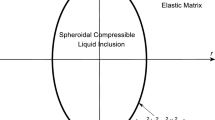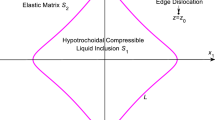Summary
An investigation is made of the phenomena occurring at the contact of elastic spheres, subjected to forces with varying tangential component, in one direction, with changing sign, and varying normal component. The contact law is based on the assumption, introduced by H. Hertz [3], that both bodies behave physically like elastic half-spaces. We assume constant stress directions in the slip area in order to use so-called Cattaneo-Mindlin functions to solve the tangential boundary value problem. The stress distribution of the Cattaneo-Mindlin theory [2], [8] is rotational symmetric and has a typical break at the border of the stick area at ϱ=a 1 * fora 1 *<a 1, with the radiusa 1 * of the stick area and the radiusa 1 of the contact area. The general solution of the tangential contact problem can be written as a sum of Cattaneo-Mindlin functions. The appropriate superposition of two Cattaneo-Mindlin functions yields a new Cattaneo-Mindlin function, which simplifies the calculation of the force and the displacement. We will arrive at a formula for the force-displacement relation of general load-histories, which can be reduced to the compliances of Mindlin & Deresiewicz [9] by differentiation. In contrast to Mindlin & Deresiewicz our formula depends only on the points of instantaneous adhesionP i , for 1≦i≦N−1, and the current displacements ξ N , ζ N in tangential and normal direction of the initial contact point, which simplifies the solution. It also allows a generalization for oblique load-histories with elliptical contact areas and tangential forces in varying directions [4]. Finally an algorithm is given, which determines the essential number of Cattaneo-Mindlin functions.
Übersicht
Es werden die Phänomene untersucht, die beim Kontakt elastischer Kugeln unter der Einwirkung von Kräften mit veränderlicher, unidirektionaler Tangentialkomponente mit veränderlichem Vorzeichen und veränderlicher Normal-komponente auftreten. Das Kontaktgesetz beruht auf der von H. Hertz [3] eingeführten Annahme, daß sich beide Körper physikalisch wie elastische Halbräume verhalten. Wir nehmen konstante Spannungsrichtungen im Gleitgebiet an, um mit Hilfe sogenannter Cattaneo-Mindlin-Funktionen das tangentiale Randwertproblem zu lösen. Die Spannungsverteilung der Cattaneo-Mindlin-Theorie [2], [8] ist rotationssymmetrisch und hat einen typischen Knickpunkt am Rand des Haftgebiets an der Stelle ϱ=a 1 *, füra 1 *<a 1, mit dem Radiusa 1 * des Haftgebiets und dem Radiusa 1 des Kontaktgebiets. Die allgemeine Lösung des tangentialen Kontaktproblems kann als eine Summe von Cattaneo-Mindlin-Funktionen dargestellt werden. Die geeignete Überlagerung von zwei cattaneo-Mindlin-Funktionen ergibt eine neue Cattaneo-Mindlin-Funktion, was die Berechnung der Kraft und der Verschiebung beträchtlich vereinfacht. Wir leiten eine Formel für die Kraft-Verschiebungs-Beziehung bei allgemeinen Belastungsgeschichten her, die durch Differentiation auf die Nachgiebigkeiten von Mindlin & Deresiewicz [9] reduziert werden kann. Im Gegensatz zu Mindlin & Deresiewicz hängt unsere Formel nur von den Punkten momentanen HaftensP i (für 1≦i≦N−1) und von den aktuellen Verschiebungen ξ N und ζ N in tangentialer und normaler Richtung des anfänglichen Kontaktpunktes ab, was die Lösung vereinfacht. Es ermöglicht auch eine Verallgemeinerung für schiefe Belastungsgeschichten mit elliptischen Kontaktgebieten und Tangentialkräften mit veränderlicher Richtung [4]. Schließlich wird ein Algorithmus angegeben, welcher die notwendige Zahl von Cattaneo-Mindlin-Funktionen bestimmt.
Similar content being viewed by others
References
Barber, J. R.: Adhesive contact during the oblique impact of elastic spheres. Journal of Applied Mechanics and Physics, ZAMP 30 (1979) 468–476
Cattaneo, C.: Sul Contatto die due corpi elastici: distributione locale degli sforzi. Academia Nationale dei Lincei, Rendiconti, Serie 6, 27 (1938) 342–348, 434–436, 474–478
Hertz, H.: Über die Berührung fester elastischer Körper. Journal für die reine und die angewandte Mathematik (Crelle) 92 (1882) 156–171
Jaeger, J.: Elastic impact with friction. Thesis, Delft, The Netherlands, November 1992
Johnson, K. L.: Contact Mechanics. Cambridge (UK), Cambridge University Press, 1985
Kalker, J. J.: Three-dimensional elastic bodies in rolling contact. Dordrecht, Boston, London, Kluwer Academic Publishers, 1990
Klarbring, A.: (Non-)uniqueness and (non-)existence of frictional rate problems. Euromech Colloquium 273: Unilateral Contact and Dry Friction, La Grande Motte, France, May 29-June 1, 1990
Mindlin, R. D.: Compliance of elastic bodies in contact. J. Appl. Mech. 16 (1949) 259–268
Mindlin, R. D.; Deresiewicz, H.: Elastic spheres in contact under varying oblique forces. J. Appl. Mech. 20 (1953) 327–344
Author information
Authors and Affiliations
Rights and permissions
About this article
Cite this article
Jäger, J. Elastic contact of equal spheres under oblique forces. Arch. Appl. Mech. 63, 402–412 (1993). https://doi.org/10.1007/BF00805740
Received:
Issue Date:
DOI: https://doi.org/10.1007/BF00805740




